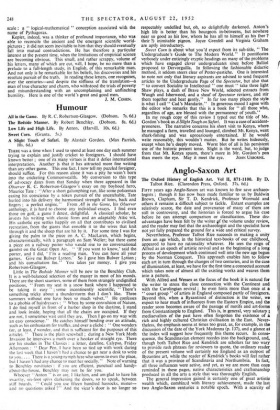Anglo-Saxon Art
Fts-ry years ago Anglo-Saxon art was known to few save archaeo- logists ; though it has now been made familiar to us by Baldwin Brown, Clapham, Sir T. D. Kendrick, Professor Wormald and others it remains a difficult subject to tackle. Extant examples are relatively scarce, the date and provenance of many of them are still in controversy, and the historian is forced to argue his case before he can attempt comparison or classification. These dis- advantages have been felt by the writer ;If the volume under review, and the reader may feel that the archaeologist and the specialist have not yet fully prepared the ground for a wide and critical survey.
Nevertheless, Professor Talbot Rice succeeds in making a unity from an age which, in the historical text-books of our childhood, appeared to have no rationality whatever. He sees the reign of Alfred as an epoch of artistic revival and as the beginning of a long process of development which continued well into the new age begun by the Norman Conquest. This approach enables him to follow each art in turn through the changes of two centuries, and in the case of illumination, at least, we have for the first time a connectedaccount which takes note of almost all the existing works and weaves them into a pattern.
With Alfred and Wessex as the focus of the book it is natural for the writer to stress the close connection with the Continent and with the Carolingian revival ; he even hints more than once at a " court group " of artists in England composed partly of foreigners. Beyond this, when a Byzantinist of distinction is the writer, we expect to hear much of influences from the Eastern Empire, and the reader soon becomes aware of the passage of motifs and art-forms from Constantinople to England. This is, in general, very salutary mediaevalists of the past have often forgotten the existence of a rich and highly cultured Christian civilisation in the East. Never- theless, the emphasis seems at times too great, as, for example, in the discussion of the date of the York Madonna (p. 137), and a glance at the index will suggest how frequently this theme recurs. In conse- quence, the Scandinavian element recedes into the background, and, though both Talbot Rice and Kendrick are scholars far too wary to provide rash phrases for reviewers to quote, the ordinary reader of the present volume will certainly see England as an outpost of Byzantine .art, while the reader of Kendrick's books will feel rather that it was a province of Scandinavia and Northumbria. In fact, all three influences were active, and yet, as we are more than once reminded in these pages, native characteristics and craftsmanship produced in all the arts a style that was thoroughly English.
The general impression gained is certainly one of great artistic wealth which, combined with literary achievement, made the last two Anglo-Saxon centuries a notable epoch. With a scarcity of extant masterpieces other than painted books, it is natural that Professor Talbot Rice should have put up a great fight to retain within the period those that are available. Thus the Romsey rood, recently relegated to the twelfth century by Kendrick, is here claimed for the early eleventh—rightly, in the opinion of the present writer, who would call attention to the presence of the dextera Dei, a typically late-tenth-century motif which did, not survive the Conquest. The York Madonna is a more difficult problem, and there is much to be said on stylistic grounds for a later date, as also (in the present writer's opinion) with the superb crozier at-the Victoria and Albert Museum, and possibly with the Chichester panels, while the Liverpool Nativity, with its classical rotundity of treatment, and the Victoria and Albert Adoration, both here claimed for England, have marked stylistic features not found in any extant work of known English provenance. As for illumination, it also has problems of its own, not the least, from the general reader's point of view, being the inadequacy of any photograph to transmit the aesthetic experience, and the difficulty of following a long catalogue of examples. In this field Professor Wormald is the master from whom all learn.
The illustrations are, as might be expected, numerous, well-chosen and beautiful. A comparison with those in Kendrick's second volume, where many of the same objects appear, shows each book to have its own strong points. Sculpture and ivory naturally score successes ; of the illuminations, fewer full pages and more details might have been welcome. A few small questions suggest them- selves. Do we really know that one-fourth of the ivories of the period have survived (p.6) ? There was only one monastery (Athelney) existing in Alfred's day (p.12) ; Blandinium (p.23) was as " Benedictine " as any other abbey, and Aethelwold had been a monk of Glastonbury. The description of Alfred's work (p.1'7) surely suggests a higher degree of culture than in fact existed. On p. 29 for Bideford read Bedford and on p. 68 for " Volpiano " understand William of Dijon. The handy neologisfn " figural " (for " figured ") is perhaps overworked, and the correct but some- how unfamiliar " porticus " (plural) occurs more than once. Whatever the reader may think, " penner " and " toggle " are



























 Previous page
Previous page